Bromeliads (Bromeliaceae) are natives of tropical and subtropical areas, but many types thrive in other climates. They add a tropical touch to your home when well cared for. This family includes plants that can look very different from one another, but they are all epiphytes. An epiphyte lives on another plant for support, such as a tree, but it is not parasitic. In addition, bromeliads can grow on soil substrate as well, and they make excellent container plants for the house. Bromeliads produce smaller plants, known as “pups,” after they flower.
A bromeliad must be mature to start developing pups, which normally happens shortly after the plant blooms. Most bromeliad species mature in one to three years, depending on the variety and the plant’s growing conditions, including temperature and humidity. The mother plant can continue producing pups for several months before it dies, which appear as off-shoots from the base of the original plant’s stem. You can transplant the mature bromeliad or its pups to containers or other areas of your garden with little trouble.
Some bromeliads reach over 30 feet tall when found in their natural habitat. Cultivated species range between 2 to 4 feet tall and spread equally wide. The flower stem sprouts from the center of the leaf rosette. Many varieties grow variegated leaves with white, yellow or red spots or stripes. Different Bromeliad plant varieties include:
- Puya (Puya ssp)
- Hechtia Bromeliad (Hechtia ssp)
- Aechmea Bromeliad (Aechmea ssp)
- Guzmania bromeliads (Guzmania ssp)
- Neoregelia (Neoregelia ssp)
- Vriesea bromeliads (Vriesea ssp)
- Tillandsia bromeliads ( Tillandsia ssp)
- Billbergia (Billbergia ssp)
- Cryptanthus (Cryptanthus ssp)
- Dyckia (Dyckia ssp)
- Cataposis (Cataposis ssp)
- Quesnelia Bromeliad (Quesnelia ssp)
- Ananas Bromeliad (Ananas ssp)
- Hohenbergia Bromeliads (Hohenbergia ssp)
- Pitcairnia Bromeliad
- Nidularium (Little nest bromeliads)
Puya Bromeliads

Puya is a very large genus of bromeliad, both in number of species and in size of plant. The genus includes the world’s largest species of bromeliad the Puya ramondii which grows up to 30 feet tall and 9 feet across. There are about 199 species within the Puya genus.Puyas are hardy because of where they grow naturally.
Many Puyas have long, spiked leaves that form in a round, ball-like rosette. Many Puyas resemble yuccas, agave and other succulent plants, but they are not related to one another. Puyas adjust to arid conditions by suspending their growth while true succulents store water in their tissues.
Unlike most bromeliads Puyas are terrestrial, growing in the ground instead of growing as epiphytes in trees. They have roots that take up nutrients and water from the soil as opposed to the air. Varieties of Puya Bromeliads include:
- Puya mirabalis which has dense grass-like leaves. They are narrow and flexible, but have very sharp spines. The leaves form a ball shaped clump. This plant typically reaches maturity between one and two years and will produce a flower stalk at that time.
- Puya Tuberosa which is a small plant compared to most Puyas. It only grows about 20 inches wide and 20 inches tall. Like most Puyas the tubular shaped leaves have sharp spines around the margins. A spike rises above the center of the plant and produces purple flowers with orange pollen.
- Puya dyckioides. This Puya is similar to bromeliads in the Dyckia genera from which it derives its name. It comes from Argentina, found at around 10,000 feet. It is known to withstand temperatures down to 12 degrees. It has dark green glossy leaves that are jagged with spikes. The flower spike can rise up to 30 inches from the base of the plant. It has clusters of pink inflorescence that produce small turquoise blue flowers.
- Puya berteroniana. This Puya is also called the turquoise Puya. It is known for its giant flower spike that produces clusters of large, brilliant turquoise flowers. The flowers also have bright orange anthers. This same species has a form that produces bright blue flowers also. The Puya berteroniana grows up to four feet across and tall and can take between six and eight years to reach mature flowering size.
- Puya alpestris which grows about two feet tall and two feet wide. It has narrow, dark green leaves with large teeth surrounding the leaf margin. It has a flower spike that rises from the center of the plant and produces brilliant blue flowers.
Hechtia Bromeliads

Hechtia is a genus of plants in the family Bromeliaceae. The plants are terrestrial with characteristic rosette form of most bromeliads. The thick, waxy leaves are sword-like and radiate from a central point in a rosette. Leaf edges may have some serration. The genus comes in a rainbow of colors both in foliage and in flower. Leaves may be tinged with bronze, gold, red, purple, and pink.
Flowers are born on erect stalks and are usually white but may be pink or yellow. Plants grow slowly but some forms may eventually achieve 5 feet in width and have a flower stalk of 8 feet in height. Species of Hechtia include:
- Hechtia caerulea. This is a small bromeliad with thin, long, bright green leaves. The leaves drape downward making this plant ideal for hanging planters. It also has very few spines, making it slightly less dangerous to hang than other Hechtias.
- Hechtia rosea. This bromeliad is one of the few Hechtias that boasts beautiful flowers. It produces a tall flower stalk with attractive pink/red flowers. The foliage also blushes red at the center when flowering.
- Hechtia montana. Hechtia montana is a very hardy large growing plant. It is ideal for large outdoor landscaping spaces. The plant is a dark green with sharp white teeth.
- Hechtia glauca. This plant has some of the thickest leaves in the Hechtia genera. They are leathery and succulent looking. They are a beautiful turquoise color with a silvery powdered coating. They can grow up to 18 inches across.
- Hechtia texensis. The plant can grow as large as 18 inches across and can produce a flower stalk as tall as 2 feet. It becomes bright red toward the outer edges of the thin leaves and yellow-green towards the center. It has sharp white teeth that surround its leaf margins.
Aechmea Bromeliads
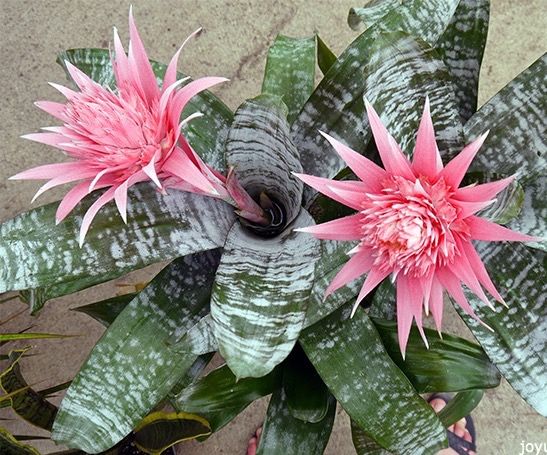
Most Aechmeas are epiphytic meaning they grow non-parasitically on another host such as a tree. Some have adapted for growth in moist, shady forests while others prefer more arid regions. Many Aechmeas have sharp spines along the margins or outer edges of their leaves.
Aechmea broemliads offer a great variety in color, foliage, and growth habits. Aechmea’s foliage grows without a stem. The leaves grow together forming a rosette shape at the center of the plant. It takes in water through this rosette, which is more commonly referred to as a tank. The Aechmea’s ability to store up water in its tank to be used as needed helps it to survive through periods of sporadic rainfall. Cultivars of Aechmea include:
- Aechmea fasciata: This commonly available funnel-shaped plant has leaves that are curved at the top and numerous light blue flowers borne in a dense pink spike.
- Aechmea fendleri: A large panicle of blue berries and almost purplish bracts top a 24 -to 30-inch rosette of light green leaves.
- Aechmea ‘Foster’s Favorite’: Upright rosette with striking lacquered wine-red leaves; pendant spike of coral red pear-shaped berries tipped with midnight blue flowers.
- Aechmea chantinii: Colorful open rosette of hard olive green leaves with pronounced pinkish-gray cross bands. The flower stalk is a branched spike with tight red bracts tipped yellow.
Guzmania Bromeliads

Guzmania Bromeliads add significant intrigue, color and beauty to your Green Space. They have long, slender evergreen leaves that are topped by a single brilliant inflorescence of tongue-like petals. The bloom will be deep red, maroon, orange, pink, or yellow, or some combination thereof.
The plant dies after it has produced its flowers in summer, but new plants can easily be propagated from the offsets which appear as the parent plant dies. They are epipthytes and can do well if tied on to pieces of bark with roots bound into sphagnum moss. Cultivars of Guzmania bromeliads include:
- Guzmania lingulata: The flower stalk grows out of the rosette of leaves and has bracts ranging in color from yellow to orange to red to deep purple. Many color variations have been selected and named. G. lingulata and its hybrids are easy to grow.
- Guzmania zahnii: This air pine has a brilliant red and yellow flower stalk. It is easy to grow, but some of the hybrids developed from it are more challenging.
Neoregelia Bromeliads

Possibly, the showiest of bromeliads, their colorful leaves produce brilliant shades when located in a bright light situation. The plant has a sizeable rosette of bright green leaves, banded in white with a red tank. The tank looks as though a can of red paint was poured over it. Brief blooms are violet.
Neoregelia, like all bromeliads, spreads by producing offsets or plantlets around the base of mature plants. After the mature plant has flowered, the mother plant will gradually die back as the pups take over. Cultivars of Neoregelia include:
- Neoregelia spectabilis: Leaves are narrow, gray-striped beneath, green above with red tips. The inner leaves are edged in purple with blue flowers.
- Neoregelia carolinæ: When in flower, the leaves turn red, attracting insect pollinators. In its natural habitat, this plant is often used as a shelter by many animals, including frogs.
- Neoregelia ‘Guinea’: This highly speckled bromeliad is a small grower at about 6 to 8 inches in a compact, somewhat upright rosette.
- Neoregelia meyendorffii ‘Spineless’: Growth is compact, in tight rosettes. The leaves are glossy and flush bright red at flowering.
- Neoregelia ‘Morado’: A wide-leafed purple-centered plant that will reach maximum color in low light conditions. The deep green, white-edged leaves flush when in bloom. In intense light, it develops dark concentric bands.
Vriesea Bromeliads
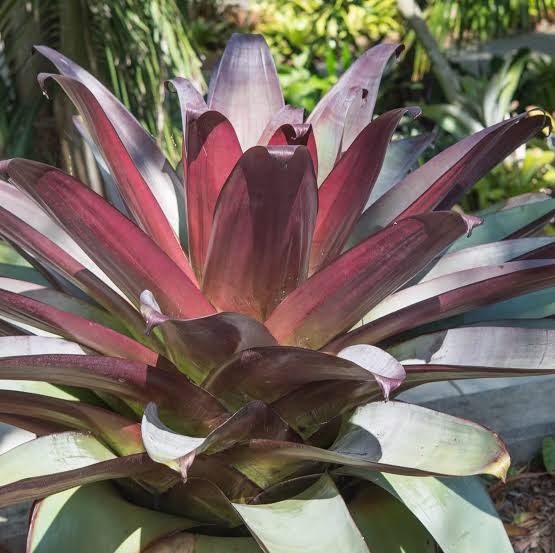
Containing some of the largest bromeliad species, these tropical plants harbor a wide variety of insect fauna, unlike the smaller Catopsis species. In the wild, frogs may go through their whole life cycle in a bromeliad. This genus is closely related related to Guzmania. Both Guzmania and Vriesea have dry capsules that split open to release parachute like seeds.
Most Vriesea are epiphytes and grow soil-less on trees. they have no roots but have special hold fasts that do not take in any nutrients. All nutrients are taken in through the center “tank” made by a rosette of leaves.
- V. carinata: Compact, has a flat flower stalk, with yellow, orange, or red bracts. It has been used to produce many hybrids.
- V. flammea: Red flowers, recommended for beginning bromeliad growers.
- V. bleheri: Green leaves shaded purple and bright yellow bracts.
- V. guttata: The green leaves are spotted brown. Pendulous flowers lined with pink bracts.
- V. saundersii: Compact, has beautiful silver-grey leaves.
- V. fenestralis: has yellow-green leaves marked dark green.
Hybrid Vrieseas
- ‘Christianne’: Glossy green leaves with bright, waxy red spikes and yellow flowers. Rarely exceeds 12 inches.
- ‘Splenriet’: The dark green leaves are marked with wide purplish-black bands. Bright yellow flowers emerge from a vibrant red-orange spike.
- ‘Charlotte’: An excellent plant with a colorful branched spike of yellow, with a little red. They can grow to 18 inches tall or so but will stay smaller if grown in a small container
- ‘Ella’: A small hybrid with crimson branches and yellow flowers. Perfect for terrariums or other small spaces.
Tillandsia Bromeliads
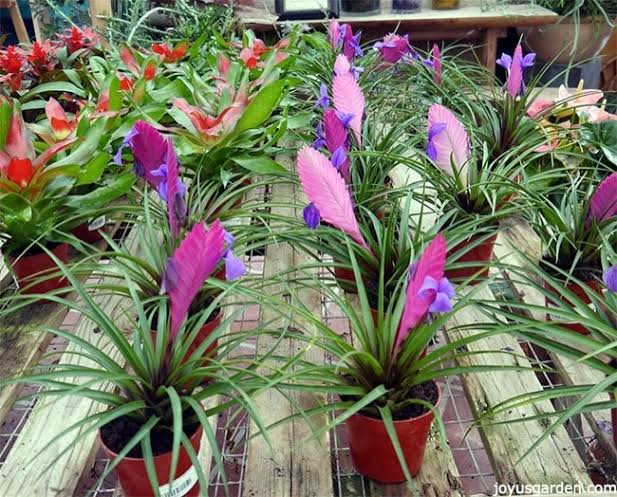
Tillandsia, commonly known as air plants are naturally epiphytic air plants that grow by clinging to trees and extracting excess moisture from the air. Once rare, tillandsia is now common in garden centers, where they are frequently sold as part of hanging gardens.
Like many other members of the Bromeliad family, the majority of air plant species grows in a rosette fashion. They feature a sort of central “cup” that water collects in. Their blooms are usually very colorful, often pink, purple, and yellow, and they result in little seed parachutes that are naturally carried by the wind. Varieties of Tillandsia Cultivars include:
- Tillandsia usneoides – Spanish Moss: Spanish moss is native from the coast to the lower piedmont in South Carolina. The slender stems hang to 20 feet or more over trees, fences, and telephone wires. It can also be grown indoors in bright light.
- Tillandsia cyanea: This is the most popular species of air plants. Striking pink quill-like bracts surround large, bright purple flowers. The foliage of this terrestrial species is a mass of thin, recurved green leaves in a rosette form.
- Tillandsia utriculata v. pringleyi: A decorative species with rather thin, grayish silver leaves in an upright rosette. The flower stalk is branched and red to orange or pink, with green.
- Tillandsia caput-medusae: This easy to grow, clumping species has silvery twisty leaves and a bulbous base. The flower stalk is red.
- Tillandsia plumosa: This plant forms a ball of fuzzy silver leaves that grow on rocks and limbs in dry forests.
Cryptanthus Bromeliads

Cryptanthus bromeliads, more commonly known as earth stars due to rosette-shaped arrangement of the leaves and their low growth habit. Their colors range from dark green to bright pink to red, and they can be banded, spotted, solid, or virtually any other pattern.
Like most bromeliads, Cryptanthus species are mostly grown for their interesting leaves, but they also produce small but beautiful white or pink blooms. The plants bloom only once, however, before the plant produces offsets (pups) and then dies. The life cyle of these plants is about three years from pup to flowering plant. Varieties and Cultivars of cryptanthus include:
- Cryptanthus bromelioides var. Tricolor: The beautiful foliage is striped white on green.
- Cryptanthus ‘It’: White-and green-striped leaves are tinged pink on plants grown in bright light.
- Cryptanthus fosteriana: This earth star has chocolate-brown leaves with zebralike gray stripes.
- Cryptanthus zonatus ‘Zebrinus’: ‘Zebrinus’ has reddish-brown leaves with silvery zigzag bands.
- Cryptanthus ‘Black Prince’: ‘Black Prince’ has deep maroon to almost black foliage; the leaves are stiff and fleshy.
Quesnelia Bromeliads

The genus is named after French businessman and patron of botany Edouard Prosper Quesnel, of Le Havre. Its leaves, lanceolate and light green to dark green, grow into a rosette that stays close to the ground, reaching a maximum height of 40 centimeters. The flowers are grouped in terminal inflorescences, that is, after the wilting of their petals, they and the plant that produced them also die, leaving only the suckers. Its cultivars include:
- Quesnelia arvensis— The plants grow 2 to 3 foot tall with an equal spread. The long, strap-like leaves have finely serrated margins. In early spring the pinkish-red flower spike emerges from the center of the plant and rises up above the foliage.
- Quesnelia testudo— Quesnelia testudo is very striking with its very colorful Inflorescence. Its bright green leaves with its sharp leaf tips add to its attraction on this unusual Species. Able to withstand full sunlight and very prolific growing into a nice cluster in the landscape.
- Quesnelia marmorata ‘Tim Plowman’— It is known for its tall, upright leaves that curl at the top. The thick leaves are green with reddish-purple spots on the inner and outer sides of the leaves. A mild wash of silver is evident giving it an overall pale green appearance. The inflorescence is branched on a tall spike with pink bracts and blue flowers.
- Quesnelia humilis— Growing to only about 6 or 8 inches tall in an upright vase-shape, nearly tubular rosette. The foliage is green, with a ‘thumb-print’ or indented area near the base of each leaf. The inflorescence is vivid, with red bracts and violet-tipped red flowers on a short scape. Makes an attractive clump due to its stoloniferous habit.
- Quesnelia seideliana— This quesnelia species has an unusual turquoise colored bloom. The dark-green, simple leaves are arranged in rosettes. They are linear and sessile with entire margins and parallel venation.
- Quesnelia tubifolia— A bulbous or bottle-shaped plant, it has leaves with broad sheaths tapering abruptly to a broadly lingulate, short blade with serrate margins. The leaves bend outward and leave a deep wrinkle or ‘thumbprint’ at the top of the leaf base. The inflorescence is short but emerges above the rosette, sparsely flowered, bipinnate with rose colored bracts and reddish flowers.
Ananas or Pineapple Bromeliads
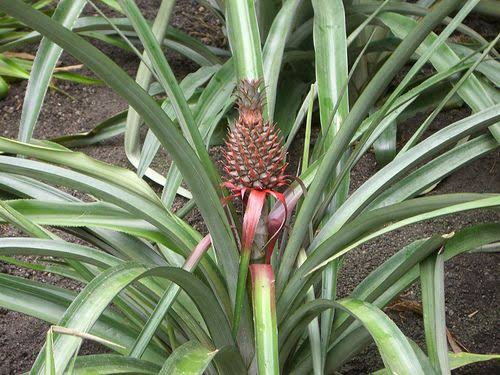
The plant has a short, stocky stem with tough, waxy leaves. When creating its fruit, it usually produces up to 200 flowers, although some large-fruited cultivars can exceed this. Once it flowers, the individual fruits of the flowers join together to create a multiple fruit. After the first fruit is produced, side shoots (called ‘suckers’ by commercial growers) are produced in the leaf axils of the main stem. These suckers may be removed for propagation, or left to produce additional fruits on the original plant. Varieties of Pineapple bromeliad include:
- Variegated Pineapple (A. comosus v. variegatus): Variegated pineapple has longitudinally striped leaves that turn pink in bright light.
- Red Pineapple (A. bracteatus v. tricolor): The fruit is large and reddish, with numerous offsets at the bottom.
- Dwarf Pineapple (A. nanus): Dwarf pineapple looks like a dwarf version of A. comosus with tiny, thumb-sized fruit.
Hohenbergia Bromeliads

Hohenbergia are beautiful flowering bromeliads with very attractive foliage. They can grow quite large and typically have broad strap like leaves that are stiff and leathery. Some Hohenbergia remain upright, while others have leaves that bow out at the ends. The leaves often come together to form a tight rosette shape. Hohenbergia usually produce tall flower spike. Their flower spike is what distinguishes them from their close relatives in the Achmea genus. Varieties of this species include:
- Hohenbergia augusta
- Hohenbergia belemii
- Hohenbergia catingae
- Hohenbergia castellanosii
- Hohenbergia conquistensis
- Hohenbergia pabstii
- Hohenbergia rosea
Pitcairnia Bromeliads
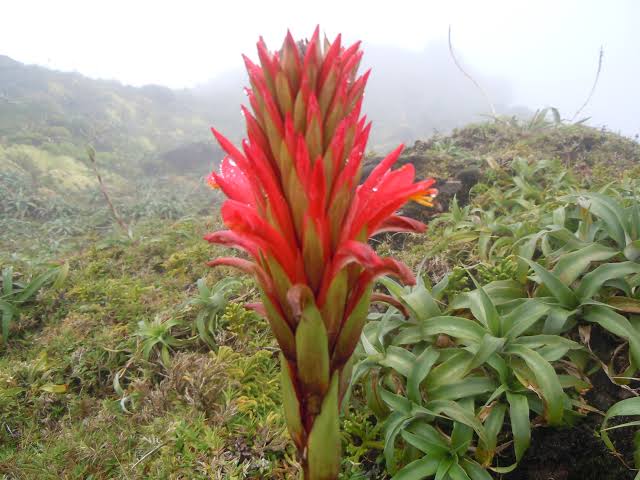
Pitcairnia are primarily terrestrial and saxicolous meaning the grow either in the ground or attached to rocks. There are few species that can also be found growing as epiphytes in trees. Pitcairnia are characterized by softer drooping leaves, a few of which have spines, while others are remain spineless. This is opposed to many other genera of bromeliads that have stiff leaves.
Pitcairnia also often send up tall, brightly colored flower stalks. The flower stalks usually produce thin tube shaped flowers that project at right angles from the stalks. Flower stalks and flowers are typically found in pinks, reds, oranges and occasionally in yellows and whites. Cultivars of Pitcairnia include:
- Pitcairnia cataractae which is a unique plant with dark green glossy leaves. It is a smaller Pitcairnia growing no more than two feet tall. The green flower spike is small and produces delicate white flowers that hang downward from the flower spike.
- Pitcairnia ringens which produces light green leaves that are spineless and smooth. The leaves can grow up to 3 feet long. The plant sends up a conspicuous red flower spike that produces bright red showy flowers.
- Pitcairnia maidifolia which has broad dark green leaves that are deeply veined. It produces a tall pink and green flower spike with white tubular flowers.
- Pitcairnia xanthocalyx which has floppy dark green leaves that can resemble ornamental grass. It boasts a two foot tall flower stalk that, unlike most other Pitcairnia species produces yellow and white flowers. This plant is best used as a landscape plant in moderate climates.
- Picairnia andreana which is a small species that reaches about one foot tall and one foot wide. It has narrow silvery gray leaves and produces flowers that are orange toward the bottom and become yellow toward the top.
- Pitcairnia undulata which is very unique from other Pitcairnia and from other bromeliads. Unlike most bromeliads, this species grows very broad leaves on petioles or stems. The leaves are discolor with dark green on top and silver on the undersides. It produces a long flowering, simple red spike. This plant generates pups easily and forms clusters that reach two feet wide and up to 30 inches tall.
Nidulariums Bromeliads
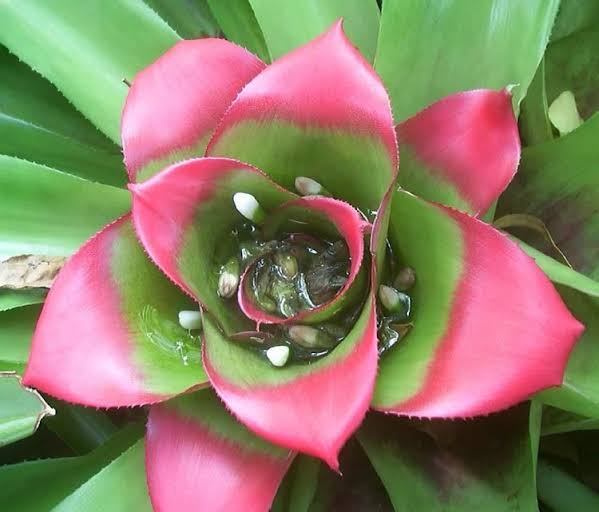
Commonly confused with Neoregelia which they resemble, this plant group was first described in 1854 and named to describe the nestling characteristic of the inflorescence. Nidulariums are medium-sized plants with inflorescences forming low in the center of the rosettes.
At flowering time the collaret of shortened inner leaves turns brilliant red, rose or cerise, depending on the species. The flowers are red, white or blue and the leaves are usually glossy and finely spined. In some varieties the inflorescence rises above the plant and creates a striking picture. Varieties of Nidulariums include:
- Nidularium albiflorum
- Nidularium alvimii
- Nidularium angustifolium
- Nidularium amorimii
- Nidularium azureum
- Nidularium ferrugineum
- Nidularium corallinum
- Nidularium longiflorum
Dyckia Bromeliads

Dyckia are bromeliads sharing that group’s characteristic rosette shape. They are not technically succulents, as they do not store water in their leaves, but they do have similar thick, waxy foliage. The genus is named after the Prussian botanist, botanical artist and horticulturist The Prince and Earl of Salm Reifferscheid-Dyck.
The leaves vary from long and strappy to short and scalloped. All foliage is fairly rigid and may be smooth or serrated and a solid color or variegated or spotted. Long stalks with multiple red, yellow, or orange flowers appear in spring.
Dyckia growing conditions in their natural setting should be mimicked as much as possible. Try growing Dyckia plants outside in summer or year-round in warmer regions. Varieties of Dyckia bromeliads include:
- Dyckia ‘Arizona’ is a popular cultivar that has narrow burgundy leaves with white spines. The rosette forms a beautiful star shape. The cultivar is particularly adapted to arid climates.
- Dyckia ‘Naked Lady’ is a cultivar that is spineless. It has light green to yellow leaves. This plant can grow over 12 inches tall.
- Dyckia fosteriana has beautiful silvery white leaves with many spines. It forms a tight rosette with leaves that drape downward. The plant can grow up to 8 inches wide.
- Dyckia ‘Cherry Coke’ has glossy leaves. Its name is suitable because the leaves are the color of Cherry Coke. The plant can grow very large with leaves up to 2 feet in length and displays a 4 foot upright flower stalk. The plant also pups well.
- Dyckia delicata comes in various forms. Leaf colors include green, red and silver depending on the form of the plant. All forms appear to be beautifully flocked with silver. Native to higher altitudes in southern Brazil, these plants are well suited to cooler winter weather. It is a beautifully shaped plant with a tight rosette draping downward.
- Dyckia brevifolia has short, wide green leaves with very small spines around the margins. While drought tolerant, these plants can also survive chilly and wet weather. They grow about 8 inches wide and have a beautiful small yellow flower which grows on a flower stalk.
Catopsis Bromeliads
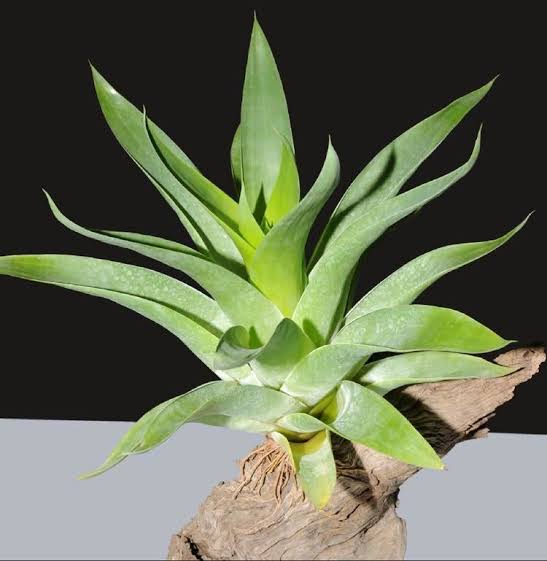
Catopsis is a genus of bromeliad whose name comes from the Greek word “katopsis” meaning view. Catopsis bromeliads generally grows on the unshaded twigs of trees, and has been shown experimentally to trap more insects in its tank than other bromeliads of comparable size.
The leaves often curl back and downward away from the plant. Typically the leaves are spineless and flowers protrude from the center on long stalks. Catopsis is a relatively small genus of bromeliads with only eighteen species and a few cultivars, that is:
- Catopsis berteroniana which is one of only a few bromeliads that are considered carnivorous. Catopsis berteroniana are nicknamed the jungle lantern because of their iridescent yellow color. They are also coated in a powdery wax that seems to enhance the glowing appearance.
- Catopsis nutans which is also called the nodding airplant, is another rare and endangered bromeliad. The plant can be found in shady cypress swamps and sloughs. It has floppy bright green leaves that grow up to a foot long and taper toward the top. The flowers, which open at night occur from fall to spring. The yellow or orange flowers emerge on a simple flower stalk.
- Catopsis morreniana which has glossy, green leaves with silvery scales and a branched flower stalk that produces delicate, yellow flowers.
Billbergia Bromeliads

Billbergia was first described in 1821 by Carl Peter Thunberg, who honoured the late, Gustaf Johan Billberg, a Swedish botanist and lawyer in the early 19th-century. Several species are grown indoors as decorative plants for their colourful foliage, flowers, or bracts (leaflike clusters beneath the flowers). The stiff, spiny, often strap-shaped leaves grow in a rosette, sometimes up to 90 cm (35 inches) in diameter, directly from the root. The flowers are on a spike or panicle (loose cluster) growing from the centre of the rosette.
There are several popular Billbergia varieties. The following is a list of Billbergia varieties that would be an excellent addition to any bromeliad collection:
- Billbergia nutans which has green to silvery green leaves that stand upright to make a sort of vase before dropping over. The plant can grow up to 2 feet tall and a foot wide. It has beautiful flowers that hang in pendant form. The inflorescence is typically varying shades of pink.
- Billbergia saundersii which has a blush reddish pink in full sun areas. In partial sun the leaves are deep green with white spots. The plant grows about a foot tall. It produces spectacular pendant inflorescence with pink bracts and blue and white flowers.
- Billbergia zebrina is another unique variety of Billbergia. Its name comes from the silvery horizontal banding on the foliage. The plant produces a large pendant flower with pink bracts and has tightly recurved bright green petals. This plant is also commonly referred to as “queen’s tears.”
- Billbergia ‘Casa Blanca’ which has deep green leaves that are covered in beautiful white mottling. The leaves stand straight up creating a tube shaped rosette. The inflorescence is erect with pink bracts a bluish flowers.
- Billbergia pyramidalis which is one of the most beautiful variety of Billbergia. It is very cold tolerant and requires very little care. The plant clumps readily and will grow in shade or full sun. The amount of sunlight will affect the color of the leaves. It produces full, rounded pink and purple flowers during late summer.